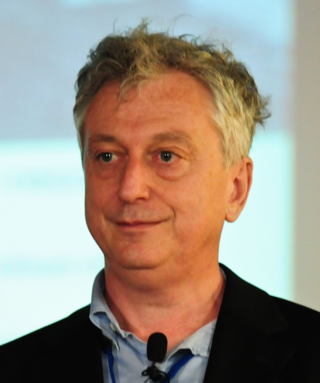Related Research Articles

The VLT Survey Telescope (VST) is a telescope located at ESO’s Paranal Observatory in the Atacama Desert of northern Chile. It is housed in an enclosure immediately adjacent to the four Very Large Telescope (VLT) Unit Telescopes on the summit of Cerro Paranal. The VST is a wide-field survey telescope with a field of view twice as broad as the full Moon. It is the largest telescope in the world designed to exclusively survey the sky in visible light.

The Galileo National Telescope, is a 3.58-meter Italian telescope, located at the Roque de los Muchachos Observatory on the island of La Palma in the Canary Islands, Spain. The TNG is operated by the "Fundación Galileo Galilei, Fundación Canaria", a non-profit institution, on behalf of the Italian National Institute of Astrophysics (INAF). The telescope saw first light in 1998 and is named after the Italian Renaissance astronomer Galileo Galilei.
The Joint Institute for Very Long Baseline Interferometry European Research Infrastructure Consortium (JIVE) was established by a decision of the European Commission in December 2014, and assumed the activities and responsibilities of the JIVE foundation, which was established in December 1993. JIVE's mandate is to support the operations and users of the European VLBI Network (EVN), in the widest sense.
The Cagliari Observatory is an astronomical observatory owned and operated by Italy's Istituto Nazionale di Astrofisica. It is located 20 km away from Cagliari in Sardinia. It was founded in 1899 to study the Earth's rotation.

The Astronomical Observatory of Capodimonte is the Neapolitan department of Istituto Nazionale di Astrofisica, the most important Italian institution promoting, developing and conducting scientific research in the fields of astronomy, astrophysics, and space science.

The Observatory of Turin is an astronomical observatory owned and operated by Italy's National Institute for Astrophysics. It is located on the top of a hill in the town of Pino Torinese near Turin, in the north Italian Piedmont region. The observatory was founded in 1759. At Pino Torinese, several asteroid discoveries were made by Italian astronomer Luigi Volta in the late 1920s and early 1930s. The asteroid 2694 Pino Torinese was named after the observatory's location.

The Brera Observatory is an astronomical observatory in the Brera district of Milan, Italy. It was built in the historic Palazzo Brera in 1764 by the Jesuit astronomer Roger Boscovich. Following the suppression of the Jesuits by Clement XIV on 21 July 1773, the palace and the observatory passed to the then rulers of northern Italy, the Austrian Habsburg dynasty.

Astronomical Observatory of Trieste is an astronomical center of studies located in the city of Trieste in northern Italy.
The Istituto di Radioastronomia di Bologna is one of research facilities of the Italian Istituto Nazionale di Astrofisica. Staff conduct research in astronomy, physics, engineering and information science. It was previously part of the Consiglio Nazionale delle Ricerche.

The Astronomical Observatory of Rome is one of twelve Astronomical Observatories in Italy. The main site of the Observatory is Monte Porzio Catone. Part of the Istituto Nazionale di Astrofisica since 2002.

The National Institute for Astrophysics is an Italian research institute in astronomy and astrophysics, founded in 1999. INAF funds and operates twenty separate research facilities, which in turn employ scientists, engineers and technical staff. The research they perform covers most areas of astronomy, ranging from planetary science to cosmology.
Astronet is a consortium which gather European funding agencies in order to establish a comprehensive long-term planning for the development of European astronomy. The consortium started on September 1, 2005.

ESPRESSO is a third-generation, fiber fed, cross-dispersed, echelle spectrograph mounted on the European Southern Observatory's Very Large Telescope (VLT). The unit saw its first light on September 25, 2016.
Angioletta Coradini was an Italian astrophysicist and planetary scientist.

The Rapid Eye Mount telescope (REM) is a fully automatic, 60 cm aperture telescope located at ESO's La Silla Observatory at 2,400 metres altitude on the edge of the Atacama Desert in Chile. The telescope's aim is to catch the afterglows of gamma-ray bursts (GRBs). REM is triggered by a signal from a high-energy satellite such as Swift and rapidly points to the detected location in the sky. It is operated for the Italian National Institute for Astrophysics since 2002.
HARPS-N, the High Accuracy Radial velocity Planet Searcher for the Northern hemisphere is a high-precision radial-velocity spectrograph, installed at the Italian Telescopio Nazionale Galileo, a 3.58-metre telescope located at the Roque de los Muchachos Observatory on the island of La Palma, Canary Islands, Spain.

Guido Horn d'Arturo was an Italian astronomer born in Trieste, then part of the Austrian Empire. He obtained Italian citizenship after serving as a volunteer in the Italian army during the First World War. To avoid being persecuted as an irredentist by the Austrian authorities, he officially added to his surname Horn that of "d'Arturo" which he used in the war.

Nicolò D'Amico (1953-2020), also known as Nichi D’Amico, was an astronomer and President of Istituto Nazionale di Astrofisica.

Alessandro De Angelis is an Italian and Argentine physicist and astrophysicist. A Professor of Experimental Physics at the University of Padova and Professor Catedratico of Astroparticle Physics at IST Lisboa, he is mostly known for his role in the proposal, construction and data analysis of new telescopes for gamma-ray astrophysics. He is a member of Istituto nazionale di fisica nucleare (INFN), Istituto nazionale di astrofisica (INAF), Italian Physical Society (SIF), International Astronomical Union (IAU), Gruppo2003.
References
- 1 2 3 4 5 6 7 8 "Giampaolo Vettolani CV" (PDF) (in Italian). Istituto Nazionale di Astrofisica. Retrieved 14 February 2018.
- ↑ "Giampaolo Vettolani" . Retrieved 7 January 2021.
- ↑ Vetulani, Zygmunt (2014). "Z ziemi włoskiej do Sanoka. Esej o rodzinie Vetulanich". Sanok – nasza tożsamość. Historia, kultura, środowisko. Sanok: Miejska Biblioteka Publiczna im. Grzegorza z Sanoka. p. 93.
- ↑ Rotkiewicz, Marcin (2015). Mózg i błazen. Rozmowa z Jerzym Vetulanim. Wołowiec: Wydawnictwo Czarne. p. 7. ISBN 978-83-8049-092-5.